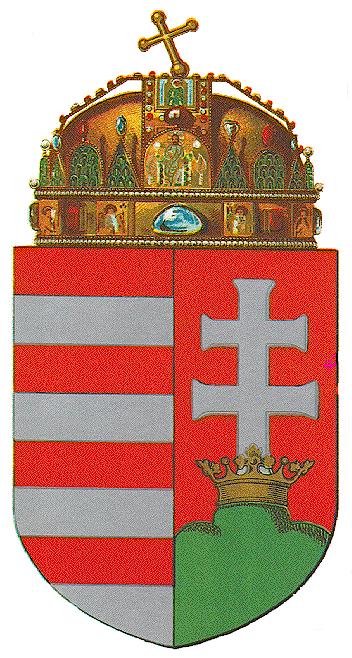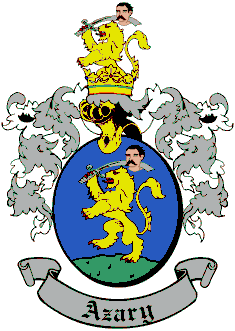
Coat of arms of the Republic of Hungary, since 1990


Other GIF images of maps and shields of Hungary available by anonymous FTP at bme-tel.ttt.bme.hu. See also a page on Hungarian coats of arms.
The arms of Hungary from 1867 to 1918 were as follows: Quarterly, 1. Azure, three leopards' heads affrontés, crowned or (Dalmatia); 2. Chequy Argent and Gules (Croatia); 3. Azure, a river in fess gules, bordered argent, thereupon a marten proper, beneath a six-pointed star or (Esclavonia); 3. per fess azure and or, over all a bar gules, issuing therefrom a demi-eagle displayed sablem addextré in chief of the sun in splendour, and senestré of a crescent argent, in the base seven towers 3 and 4, of the third ( Transylvania); enté en point Gules, a double-headed eagle proper on a peninsula vert, holding a vase pouring water into the sea argent, beneath a crown proper with bands azure (Fiume). En surtout: an escutcheon per pale Hungary Ancient (barry of 8 gules and argent) and Hungary Modern (gules, on a mount vert a crown or, issuant therefrom a double cross argent), over all an escutcheon bearing Habsburg-Lorraine (tierced in pale Habsburg, Austria and Lorraine). Crown: Saint Stephen's crown. Supporters: two angels. Motto: bizalmam az ösi erényben.
What follows was originally posted on the newsgroup rec.heraldry some years ago. Note, however, that the author was looking at color depictions of coats of arms that are discolored and misleading; his conclusions about metal-on-metal should therefore be taken with caution.
From:rorice@silver.ucs.indiana.edu(rosalyn rice) Thomas Barnes/Lothar von KatzenellenbogenI've recently been studying the pictures in Ot Evszazad Cimerei: A magyar orszagos leveltar civeres levelein by Nyulaszine Straub Eva (Corvina, Magjelent: 1987). It is appearantly a listing of all the grants of arms made by the Holy Roman Emperor/Austro-Hungarian Emperor from 1404 to 1918 and held in the National Library in Budapest (it is therefore not complete). It has over 50 color plates of arms from grants of arms and over a thousand black and white redrawings of arms with the correct heraldic hatchments. It is the most impressive armorial I have ever seen in publication. It is available via Inter-Library Loan (at least in the U.S.) and is probably still in print.
Hungarian heraldry is unlike any other style of heraldry I have ever seen. It flagrantly breaks virtually every heraldic convention even in the period that we think of as being the "classical" period of heraldry before the decadent period of the Baroque and Enlightenment periods. Tamas's assertion that Hungarian charges need to be supported by a mount comes from the 18th and 19th c. practice of putting many charges on a mount. Early Hungarian heraldry (ca. 1400) differs from German heraldry only in the fact that it tends to use more demi-beasts, crowns, and mounts or bases that German heraldry from the same period. Some Hungarian heraldry from this period is very simple. For example: Per bend sinister embattled Argent(??) and gules, two roses counterchanged.
Based on a study of the book, here's what I've discovered:
- Hungarian heraldry ignores the rule of tincture more often than it obeys it. For example:
These examples are NOT deliberately selected, they are the first three plates in the book! I most cases Hungarian heraldry ignores the rule of color on color. Sable or dark-colored proper fields are very common, as are gules charges on dark fields. Then of course there is the infamous green mount which occurs less often than you might expect.
- Or, a stork (statant?) argent. Tetenyi (Kapy) 1405
- Azure, a stork rousant contourny sable beaked and jambed gules crowned and engorged or and maintaining in its beak a snake Or. Somkereki Erdelyi 1415
- Azure, a castle of three towers gules and issuant from dexter and sinister chief a dexter and sinister arm vested gules issuant from clouds argent maintaining in honor point a crown Or. A Vadkerti, a Pataki Nagy es a Szentgyorgyi Vincze 1415
- Many charges in Hungarian heraldry issue from crowns, lines of division or bases. There are a remarkable number of "demi" creatures. In many cases this is because the charges on the shield duplicate the crest which in many cases is a demi-creature issuant from a crown. In other cases the creature emerges from the fess line of a per fess field division or a base.
- Most fields in Hungarian heraldry are azure or gules with a sprinkling of Or, argent and sable. Vert or purpure fields are never encountered. No field treatments other than barry or bendy are used. There seems to be no use of vair or ermine variant field treatements at all.
- Ordinaries are almost never used. When they occur they tend to be fesses or bends. Chevrons, palls, and palls do not appear. Field divisions tend to be per fess (quite common) or per bend (rarely). Bases are very common.
- Charges tend to be a single central charge. When multiple charges occur they are generally arranged around a large central charge. The arrangements "an X between two Ys" or "an A between in chief two mullets and in base a B" or "an A between in chief a mullet and an increscent and in base a B" are not uncommon. Any other arrangement is unusual.
- "Stylized" heraldic charges (maunches, water bourgets, millrinds, etc.) are almost never seen.
- Demi-beasts, arms couped at the shoulder (and possibly issuant from clouds), creatures arranged so as to "support" or "maintain" a central charge, and human figures occur much more frequently in Hungarian heraldry than in any other national style I have seen.
- Hungarian heraldry occasionally will use quite complex "picture heraldry", especially in the 16th and 17th centuries. For example:
- Gules, on a base vert a representation of a Hungarian man passant vested azure armed proper statant upon the body of a turk fesswise vested gules turbaned argent proper and upon the base to sinister a column argent enfiled of a vine vert crowned Or. Szentmartoni, 1549. p. 149
- Animate charges maintaining objects are not uncommon. Animals are also likely to be pierced by arrows or vulned by swords.
- Hungarian heraldry is much more "bloody" than other heraldry. In addition to the various representations of Hungarians killing Turks from 1540 onwards, you also have severed Turks heads, animals pierced by arrows, disembodied arms, human figures brandishing weapons, or occasionally animals attacking other animals.
- . Occasionally, Hungarian heraldry will arrange charges in peculiar ways. For example there is a device where a dragon is in annulo and another where a ram is eating the plant which forms the primary charge.

Hungarian heraldry is difficult to blazon because of this. If you have an arm issuant from clouds statant upon a crown striking a turk's head it is difficult to know where to begin to blazon!
Hungarian heraldry is very different from the Anglo-Norman heraldry that most people on this newsgroup are familiar with. Many people will probably think of it as being "ugly" because of this. Heralds in the Society for Creative Anachronism will be outraged by it since it repeatedly defies all of the rules for submission of SCA heraldry. However, it is fascinating because it is so different. Once you get past the reaction of "who would want THAT on their arms!" you begin to see that Hungarian heraldry is, like Polish herby or German hausmarken a unique style and is worth study on its own terms.
Last modified: